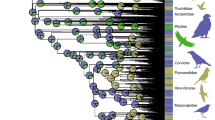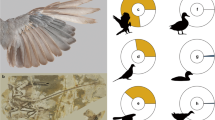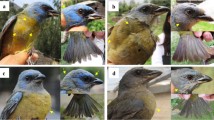Abstract
Neotropical Cardinalidae consists of 40 species in 10 genera that have diversified across the Americas. We provide quantitative information on the preformative molt of 21 Cardinalidae species of seven genera, plus one Thraupidae species placed within Cardinalidae until recently. From 155 preformative molt cards, we calculated molt extent estimates, computed frequencies of molt patterns, and summarized observed frequencies of wing-feather replacement in wing diagrams. We found 17 species with partial preformative molts, four species with eccentric preformative molts (outer but not inner primaries replaced), and one species with a complete preformative molt. Preformative molt extent and patterns were similar within Cardinalidae genera, including genera with Nearctic representatives, such as the complete preformative molt of Northern Cardinal Cardinalis cardinalis or the eccentric molt of Passerina buntings. Our results cover an important gap in the knowledge of the natural history of Cardinalidae, generate important criteria to determine the age of Neotropical Cardinalidae, and provide essential information to test hypotheses on the ecology and evolution of molt in this passerine family.



Similar content being viewed by others
References
Bååth R (2016) Package ‘bayesboot’. An implementation of Rubin’s (1981) Bayesian bootstrap. Version 0.2.1. https://github.com/rasmusab/bayesboot. Accessed 30 December 2019
Billerman SM, Keeney BK, Rodewald PG, Schulenberg TS (eds) (2020) Birds of the world. Ithaca: Cornell Laboratory of Ornithology. https://birdsoftheworld-org.proxy.birdsoftheworld.org/bow/home. Accessed 20 May 2020
Bonser RHC (1995) Melanin and the abrasion resistance of feathers. Condor 97:590–591. https://doi.org/10.2307/1369048
Burtt EH (1979) Tips on wings and other things. In: Burtt EH (ed) The behavioral significance of color. Garland STPM, New York, pp 75–110
de la Hera I, Pérez-Tris J, Tellería JL (2010) Migratory behavior and differential resource allocation between wing and tail feathers in a passerine bird. Auk 127:647–652. https://doi.org/10.1525/auk.2010.09120
de la Hera I, Reed T, Pulido F, Visser ME (2013) Feather mass and winter moult extent are heritable but not associated with fitness-related traits in a long-distance migratory bird. Evol Ecol 27:1199–1216. https://doi.org/10.1007/s10682-013-9639-x
Guallar S, Figuerola J (2016) Factors influencing the evolution of moult in the nonbreeding season: insights from the family Motacillidae. Biol J Linnean Soc 118:774–785. https://doi.org/10.1111/bij.12784
Guallar S, Jovani R (2020) Wing-feather moult phenotypes differ between the preformative and prealternate episodes and along passerine phylogeny. Ibis 162:778–786. https://doi.org/10.1111/ibi.12798
Guallar S, Santana E, Contreras S, Verdugo H, Gallés A (2009) Paseriformes del Occidente de México: morfometría, datación y sexado. Museu de Ciències Naturals de Barcelona, Barcelona
Guallar S, Ruiz-Sánchez A, Rueda-Hernández R, Pyle P (2016) Molt strategies of ten Neotropical forest passerine species. Wilson J Ornithol 128:543–555. https://doi.org/10.1676/1559-4491-128.3.543
Guallar S, Ruiz-Sánchez A, Rueda-Hernández R, Pyle P (2018) Preformative wing molt in 23. Neotropical resident passerine species. Ornitol Neotrop 29:S3–S10
Jenni L, Winkler R (1994) Moult and ageing of European passerines. Academic Press, London
Johnson EI, Wolfe JD (2018) Molt in Neotropical birds: life history and aging criteria. CRC Press, Boca Raton
Kiat Y, Izhaki I (2016) Why renew fresh feathers? Advantages and conditions for the evolution of complete post-juvenile moult. J Avian Biol 47:47–56. https://doi.org/10.1111/jav.00717
Kiat Y, Izhaki I, Sapir N (2019a) The effects of long-distance migration on the evolution of moult strategies in Western-Palearctic passerines. Biol Rev 94:700–720. https://doi.org/10.1111/brv.12474
Kiat Y, Vortman Y, Sapir N (2019b) Feather moult and bird appearance are correlated with global warming over the last 200 years. Nat Commun 10:2540. https://doi.org/10.1038/s41467-019-10452-1
Klicka J, Burns K, Spellman GM (2007) Defining a monophyletic Cardinalini: a molecular perspective. Mol Phyl Evol 45:1014–1032. https://doi.org/10.1016/j.ympev.2007.07.006
McCarthy MA (2007) Bayesian methods for ecology. Cambridge University Press, Cambridge
Pyle P (1997a) Identification guide to North American birds. Part I Columbidae to Ploceidae. Slate Creek Press, Bolinas
Pyle P (1997b) Molt limits in north American passerines. North Am Bird Bander 22:49–90
R Core Team (2019) R: a language and environment for statistical computing. R Foundation for Statistical Computing, Vienna
Rohwer S (1986) A previously unknown plumage of first-year Indigo Buntings and theories of delayed plumage maturation. Auk 103:281–292. https://doi.org/10.1093/auk/103.2.281
Rohwer S, Butler LK, Froehlich DR, Greenberg R, Marra PP (2005) Ecology and demography of east–west differences in molt scheduling of Neotropical migrant passerines. In: Greenberg R, Marra PP (eds) Birds of two worlds: the ecology and evolution of migration. Johns Hopkins University Press, Baltimore, pp 87–105
Rueda-Hernández R, Guallar S, Ruiz-Sánchez A, Pyle P (2018) The molt issue: where do we go from now. Ornitol Neotropl 29:S1–S2
Senar JC (2006) Color displays as intrasexual signals of aggression and dominance. In: Hill GE, McGraw KJ (eds) Bird coloration: function and evolution. Harvard University Press, Harvard, pp 87–136
Thompson CW (1991) The sequence of molts and plumages in Painted Buntings and implications for theories of delayed plumage maturation. Condor 93:209–235. https://doi.org/10.2307/1368938
Thompson CW, Leu M (1995) Molts and plumages of Orange-breasted Buntings (Passerina leclancherii): implications for theories of delayed plumage maturation. Auk 112:1–19. https://doi.org/10.2307/4088762
Vega-Rivera JH, McShea WJ, Rappole JH, Haas CA (1998) Pattern and chronology of prebasic molt for the wood thrush and its relation to reproduction and migration departure. Wilson Bull 110:384–392. https://doi.org/10.2307/4163963
Willoughby EJ (1991) Molt of the genus Spizella in relation to ecological factors affecting plumage wear. Proc Western Found Vert Zool 4:247–286
Young BE (1991) Annual molt and interruption of the fall migration for molting in Lazuli Buntings. Condor 93:236–250. https://doi.org/10.2307/1368939
Howell SNG, Corben C, Pyle P, Rogers DI (2003) The first basic problem: a review of molt and plumage homologies. Condor 105:635–653. https://doi.org/10.1093/condor/105.4.635
Acknowledgments
We thank the following for assistance and access to specimen collections: Maureen Flannery, California Academy of Sciences, San Francisco; Carla Cicero, Museum of Vertebrate Zoology, Berkeley; Bentley Bird, American Museum of Natural History, New York; Dr. Javier Quesada, Museu de Ciències Naturals de Barcelona; Dr. Adolfo Navarro and M.C. Fanny Rebón, Museo de Zoología Alfonso Herrera; and Dra. Patricia Escalante and M.C. Marco Gurrola, Colección Nacional de Aves, Mexico City. Constructive comments by three anonymous referees helped improve this manuscript.
Author information
Authors and Affiliations
Contributions
All authors contributed to the study conception, data collection, and study design. Analyses were performed by S.G. The first draft of the manuscript was written by S.G., and all authors commented on previous versions of the manuscript. All authors read and approved the final manuscript.
Corresponding author
Ethics declarations
Conflict of interest
R. R-H. received a grant from Dirección General de Asuntos de Personal Académico-UNAM.
Informed consent
Authors agreed with the content, gave explicit consent to submit the manuscript to Ornithology Research, and obtained consent from the reserves and museums where the data was gathered.
Additional information
Communicated by Carla S. Fontana
Publisher's note
Springer Nature remains neutral with regard to jurisdictional claims in published maps and institutional affiliations.
Rights and permissions
About this article
Cite this article
Guallar, S., Rueda-Hernández, R. & Pyle, P. Preformative molt in Neotropical Cardinalidae. Ornithol. Res. 28, 250–257 (2020). https://doi.org/10.1007/s43388-020-00024-z
Received:
Revised:
Accepted:
Published:
Issue Date:
DOI: https://doi.org/10.1007/s43388-020-00024-z




